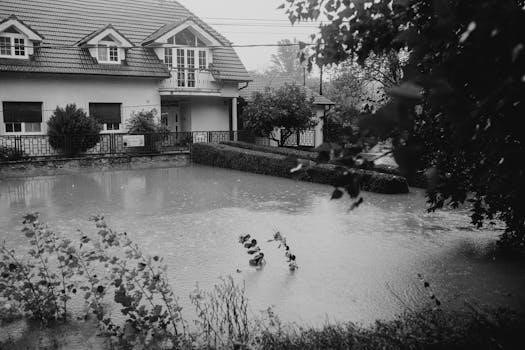
Property and Casualty Insurance Terminology PDF⁚ A Comprehensive Guide
Navigating the world of Property and Casualty (P&C) insurance can be complex‚ filled with industry-specific jargon. This guide serves as a comprehensive resource‚ offering clear definitions and explanations of key terms. Understanding this terminology is essential for both insurance professionals and policyholders alike.
The Property and Casualty (P&C) insurance industry‚ encompassing coverage for homes‚ vehicles‚ and businesses‚ relies on a specific vocabulary. This specialized terminology can often be a barrier to understanding‚ especially for those new to the field or purchasing insurance for the first time. This section aims to demystify this language.
P&C insurance involves assessing risk‚ determining premiums‚ and handling claims related to property damage or liability. Each of these stages involves a unique set of terms. For example‚ understanding the difference between “deductible” and “premium” is crucial for managing insurance costs. Similarly‚ knowing what constitutes a “covered peril” versus an “exclusion” is vital for understanding policy limitations.
This guide will provide a foundational understanding of these key concepts. We will explore the definitions of common terms‚ explain their significance within the insurance context‚ and provide examples to illustrate their practical application. By mastering this terminology‚ individuals can confidently navigate insurance policies‚ understand their rights and responsibilities‚ and make informed decisions regarding their coverage needs. We will also highlight resources for further learning.
Key P&C Insurance Terms and Definitions
This section dives into the essential vocabulary of the Property and Casualty (P&C) insurance world‚ providing clear and concise definitions for commonly used terms. Understanding these terms is paramount for anyone involved in the industry‚ from insurance professionals to policyholders seeking to protect their assets. We will explore a range of concepts that are fundamental to navigating insurance policies and claims processes.

The definitions provided here are designed to be accessible and practical. We aim to explain each term in a straightforward manner‚ avoiding overly technical jargon. Where applicable‚ we will include examples to illustrate how these terms are used in real-world scenarios. This will help you better understand the nuances of P&C insurance.
This section serves as a vital reference point for anyone seeking to enhance their knowledge of P&C insurance; Whether you’re studying for an insurance exam‚ reviewing your policy‚ or simply curious about the industry‚ this glossary will equip you with the necessary vocabulary to comprehend the complexities of P&C insurance with confidence.
Actuary
An actuary is a highly skilled professional who applies mathematical and statistical principles to assess and manage risk in the insurance and finance industries. Actuaries play a critical role in pricing insurance policies‚ determining reserve levels‚ and evaluating the financial stability of insurance companies. Their expertise is essential for ensuring that insurance companies can meet their future obligations to policyholders.
In the context of Property and Casualty (P&C) insurance‚ actuaries analyze historical data on losses‚ claims‚ and other relevant factors to predict future trends. This analysis informs the pricing of insurance products‚ allowing companies to accurately assess the risk associated with insuring various types of property and liabilities. By carefully evaluating risk‚ actuaries help insurance companies maintain profitability and solvency.
Furthermore‚ actuaries are involved in developing and implementing risk management strategies. They work to identify potential risks and develop plans to mitigate those risks. Their insights are invaluable for making informed decisions about insurance policy design‚ investment strategies‚ and other key areas of insurance company operations. Actuaries are‚ therefore‚ integral to the success and stability of the insurance industry.
Adjuster
An adjuster is a professional who investigates insurance claims to determine the extent of the insurer’s liability. Acting as a liaison between the claimant and the insurance company‚ the adjuster plays a crucial role in the claims process‚ ensuring fair and accurate settlements. They assess damages‚ review policy coverage‚ and negotiate with claimants to reach a mutually agreeable resolution.
In Property and Casualty (P&C) insurance‚ adjusters handle a wide range of claims‚ from property damage caused by natural disasters to liability claims arising from accidents or injuries. Their responsibilities include gathering information‚ interviewing witnesses‚ inspecting damaged property‚ and consulting with experts‚ such as contractors or engineers. The adjuster then evaluates the claim based on the policy terms and applicable laws.
Adjusters must possess strong analytical‚ communication‚ and negotiation skills to effectively manage claims. They must also have a thorough understanding of insurance policies and legal principles. Their work is essential for ensuring that insurance companies fulfill their obligations to policyholders while also protecting the company from fraudulent or inflated claims. Both company employees and independent contractors can act as adjusters.
Understanding Policy Coverage
Grasping the nuances of policy coverage is fundamental in Property and Casualty (P&C) insurance. A policy’s coverage dictates the extent to which an insurer will protect against potential losses. It defines the perils covered‚ the property insured‚ and the limits of liability. Understanding these elements ensures policyholders are adequately protected and can make informed decisions about their insurance needs.
Policy coverage varies significantly depending on the type of insurance and the specific terms of the policy. Factors such as deductibles‚ exclusions‚ and endorsements play a crucial role in determining the scope of coverage. A deductible is the amount the policyholder must pay out-of-pocket before the insurance company begins to cover losses. Exclusions are specific events or perils that the policy does not cover. Endorsements are additions or modifications to the policy that can expand or restrict coverage.
Careful review of policy documents is essential to fully understand the coverage provided. Policyholders should pay close attention to the definitions of key terms‚ the conditions that must be met for coverage to apply‚ and any limitations or exclusions that may exist. Seeking clarification from an insurance professional can help ensure a comprehensive understanding of policy coverage.
Casualty Insurance Definition
Casualty insurance is a broad category of coverage that protects an individual or organization against financial loss resulting from unforeseen events‚ excluding those covered by property insurance. It primarily addresses legal liability for injuries to persons or damage to the property of others. This coverage is vital for mitigating risks associated with accidents‚ negligence‚ and other potential liabilities.
Key aspects of casualty insurance include coverage for bodily injury‚ property damage‚ and legal defense costs. Bodily injury coverage protects against claims arising from injuries sustained by others due to the insured’s actions or negligence. Property damage coverage protects against claims for damage to the property of others caused by the insured. Legal defense costs cover the expenses associated with defending against lawsuits or claims.
Common examples of casualty insurance include liability insurance‚ workers’ compensation insurance‚ and auto insurance (liability portion). Liability insurance provides protection against claims for which the insured is legally responsible; Workers’ compensation insurance covers medical expenses and lost wages for employees injured on the job. Auto insurance (liability portion) covers damages and injuries caused by the insured in an automobile accident.
Property Insurance Definition
Property insurance offers financial protection against loss or damage to real and personal property due to a variety of perils. These perils typically include fire‚ windstorms‚ hail‚ theft‚ vandalism‚ and other covered events. This type of insurance is crucial for homeowners‚ business owners‚ and anyone seeking to safeguard their physical assets from unexpected disasters.
The core function of property insurance is to indemnify the insured for the actual cash value or replacement cost of damaged or destroyed property‚ depending on the policy terms. Actual cash value considers depreciation‚ while replacement cost covers the cost of replacing the property with new items. Policyholders pay premiums in exchange for this protection‚ and the specific coverage details are outlined in the insurance policy;

Common types of property insurance include homeowners insurance‚ commercial property insurance‚ and renters insurance. Homeowners insurance protects a home and its contents against covered perils. Commercial property insurance covers business buildings‚ equipment‚ and inventory. Renters insurance protects a renter’s personal belongings within a rented property. Understanding the specific coverage of each policy is essential.
Common Insurance Clauses and Provisions
Insurance policies contain various clauses and provisions that define the scope and limitations of coverage. Understanding these elements is crucial for comprehending your rights and responsibilities under the policy. One common clause is the “deductible‚” which is the amount you pay out-of-pocket before the insurance company covers the remaining costs.
Another important provision is the “exclusions” section‚ which lists specific events or circumstances that are not covered by the policy. For example‚ a policy might exclude damage from floods or earthquakes‚ requiring separate flood or earthquake insurance. “Conditions” outline the responsibilities of the insured‚ such as promptly reporting a loss and cooperating with the insurer’s investigation.
The “policy limits” define the maximum amount the insurance company will pay for a covered loss. “Subrogation” allows the insurer to recover payments from a third party responsible for the damage. “Co-insurance” clauses require the insured to maintain a certain level of coverage based on the property’s value. Carefully reviewing these clauses and provisions ensures a clear understanding of the insurance contract.
Risk Management and Insurance
Risk management involves identifying‚ assessing‚ and controlling potential risks. Insurance plays a vital role in this process by providing financial protection against certain types of losses. Effective risk management strategies aim to minimize the likelihood and impact of adverse events.

Insurance is a key tool for transferring risk from individuals or businesses to an insurance company. By paying premiums‚ policyholders gain assurance that they will be compensated for covered losses. Risk management techniques include risk avoidance‚ risk reduction‚ risk transfer (through insurance)‚ and risk retention.
Businesses use risk management to protect their assets‚ employees‚ and reputation. Individuals use it to safeguard their homes‚ vehicles‚ and financial well-being. Understanding the relationship between risk management and insurance allows for informed decisions about coverage needs. A comprehensive risk management plan‚ combined with appropriate insurance coverage‚ provides a robust defense against potential financial setbacks.
Regularly reviewing and updating your risk management and insurance strategies is crucial to adapt to changing circumstances and emerging risks.
Regulatory Bodies and Insurance
The insurance industry is heavily regulated to protect consumers and ensure the financial stability of insurance companies. Regulatory bodies at both the state and federal levels oversee various aspects of insurance operations‚ including licensing‚ solvency‚ and market conduct. These regulations aim to promote fair practices and prevent fraud.
State insurance departments are the primary regulators of insurance companies operating within their borders. They are responsible for enforcing state insurance laws and regulations‚ as well as investigating consumer complaints. These departments also monitor the financial health of insurers to ensure they can meet their obligations to policyholders;
Federal regulations‚ such as those related to anti-trust and financial reporting‚ also impact the insurance industry. The interplay between state and federal oversight helps to maintain a stable and competitive insurance market.
Understanding the role of regulatory bodies is essential for both insurance professionals and consumers. These bodies ensure that insurance companies operate ethically and responsibly‚ providing a safety net for policyholders.
National Association of Insurance Commissioners (NAIC)
The National Association of Insurance Commissioners (NAIC) is a standard-setting and regulatory support organization created and governed by the chief insurance regulators from all 50 states‚ the District of Columbia‚ and five U.S. territories. The NAIC provides a forum for developing model laws and regulations‚ which states may choose to adopt.
The NAIC’s mission is to protect consumers and help maintain the financial stability of the insurance industry. It works to promote uniformity in state insurance regulation and to facilitate the exchange of information among state insurance departments. By providing resources and support‚ the NAIC helps state regulators effectively oversee insurance companies operating within their jurisdictions.
The NAIC also develops various tools and resources for consumers‚ including educational materials and model laws‚ to help them better understand insurance products and their rights. The NAIC plays a crucial role in shaping insurance regulation and ensuring a fair and competitive insurance marketplace across the United States.
Resources for Further Learning
To deepen your understanding of Property and Casualty (P&C) insurance terminology‚ several valuable resources are available. The NAIC (National Association of Insurance Commissioners) website offers a comprehensive glossary of insurance terms‚ providing definitions and explanations for a wide range of concepts. This is an excellent starting point for beginners and seasoned professionals alike.

Insurance industry publications‚ such as those from the Insurance Information Institute (III)‚ offer in-depth articles and reports on various aspects of P&C insurance. Professional organizations like the Chartered Property Casualty Underwriter (CPCU) Society provide educational programs and certifications that can enhance your knowledge and expertise.
Additionally‚ many universities and colleges offer courses in risk management and insurance‚ which can provide a more formal and structured learning experience. Online courses and webinars are also readily accessible‚ offering flexibility and convenience for those seeking to expand their knowledge. Exploring these resources will empower you to navigate the complexities of P&C insurance with greater confidence.